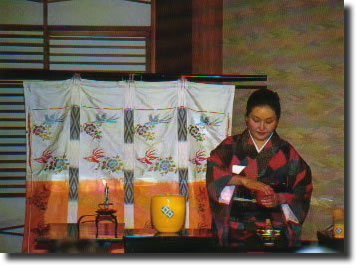
Cha-no-yu, which literally means "hot water for tea", is known in English as the tea ceremony and has as its objective a relaxed communion between the host and his guest. It is based in part on the etiquette of serving tea, but it also includes the aesthetic contemplation of landscape gardens, tea utensils, paintings, flower arrangement, and all the other elements that coexist in a harmonious relationship with the ceremony. Tea ceremony is a simply an entertainment where the guest are invited to drink tea in a pleasant and relaxing room. The bonds of friendship between the host and guests are strengthened in the ceremony when the host himself makes and serves the tea.
In
the sixteenth century, when the art was handed down to the general population,
the tea ceremony enjoyed widespread favour. Everyone, from nobles to commoners,
found in it the ideal means of relaxation from the cares of the outside
world; the tea room was a place where they could mix freely with anyone
and yet cultivate their sense of appreciation of the forms of beauty in
the setting and the use of special tea articles.
At the same time the spiritual aspect of the ceremony gave way, regrettably,
to formal etiquette, as a special code of ethics was devised to govern
the education of its devotees. This affected the general character of
the tea cult, whose finer principles of inward spirituality were substituted
by an increased concentration on outward form. We can acquire the Cha-no-yu
spirit by training in Cha-no-yu and then apply it to our daily life. Many
woman learn the tradition Cha-no-yu as part of the women's accomplishments.
Practicing cha-no-yu was also believed to develop refinement and character
along with control of the body and the mind - all traits especially prized
by Japanese.
It is a traditional Japanese way of drinking matcha (powered green tea), following set rules. The tea is made by putting matcha into a chawan (a matcha cup), pouring in hot water, stirring usually till foamy with chasen (a tea whisk made of bamboo), and then served. We feel a particularly Japanese atmosphere of graciousness to see people enjoying the Cha-no-yu in the quiet cha-shitsu (a traditional Japanese tearoom) with tokonoma ( a kind of alcove) decorated with a hanging scroll, a seasonal ikebana (flower arrangement), admiring the beautiful Japanese garden.



<Tasting matcha: usua-cha (thin, foamy tea) at ryurei (tea ceremony where tables and chairs are used)>
Materials: a sensu (a small folding fan for Cha-no-yu), a quire of kaishi (a special paper napkin used at Cha-no-yu), yoji (a cake pick).
1.
Take o-kashi (cake) onto your kaishi, and finish it before the tea is
served.
2. When you are served a cup of tea, bow in thanks to the hanto (the tea
server).
3. Take up the chawan with your right hand, putting your left hand lightly
under the chawna and place it between you and the jikaku (the guest on
your left, who is served after you). Bow to the jikyaku saying, "Osakini
chodai itashimasu (Excuse me for having tea before you). "
4. Pick up the chawan with your right hand putting your left hand lightly
under the chawan, and place it once again in front of you. Then bow to
teishu (a host of hostess at the tea ceremony) while saying, "Chodai
itashimasu (I gratefully accept the tea you have prepared). "
5. Pick up the chawan with your right hand, resting it on your left hand,
and bow your head slightly while raising the chawan lightly. Then rotate
it with your right hand clockwise twice (about 90 degrees in al). This
is because you should not drink from the front part of the chawan. Now
enjoy the tea.
6. After drinking the tea, wipe lightly the part of the rim you have drunk
from using the fingertips (thumb and forefinger) of your right hand. Wipe
once from left to right. Then wipe the fingertips on a kaishi.
7. Rotate the chawan with your right hand counterclockwise twice it was
served. Put it down on the table in front of you.
8. View the chawan with admiration (first the total shape and then the
details of the chawan). Then pick up the chawan and rotate it once again
counterclockwise twice (about 180 degrees in all), so that the front is
facing the server. Put it back where it was served.

